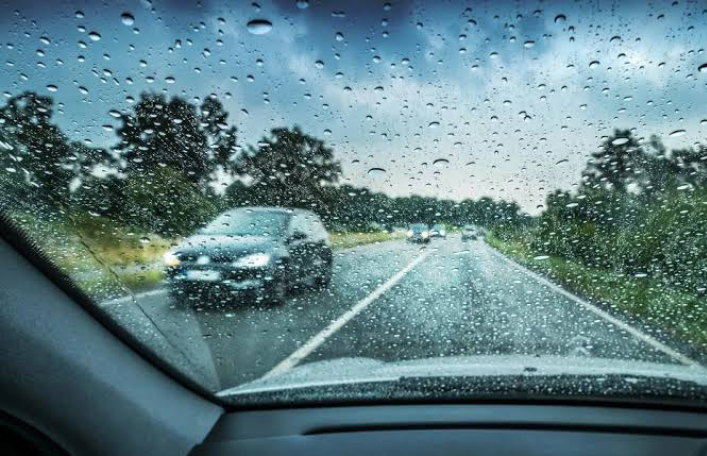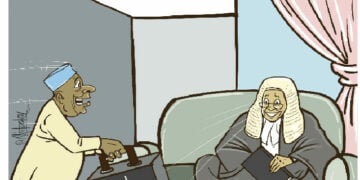I doff my hat for Premium Times. Like I did for the Nigerian Meteorological Agency (NiMET) last week, Premium Times detailed report on the Rainfall Outlook for 2025 as released by NiMET is our encyclopedia today. It was also surfed on the net last week while preparing this rainy season guide.
For emphasis, the total annual rainfall in Nigeria, as reported by Premium Times, is expected to range from 405mm in the far north to 3010mm in the coastal region. NiMET predicts that the annual rainfall total in Borno, Yobe, Sokoto, and Katsina states is likely to be less than 685mm.
I may not be an expert in this weather business, but I am told that 405mm of rain, which is 40.5 centimetres or 15.94 inches, is a significant amount and would be very dangerous for driving. Heavy rainfall, especially of this magnitude, can lead to a variety of hazards that severely impact road safety.
The hazards include reduced visibility, slippery roads, hydroplaning (when deep water causes tyres to lose contact with the road surface, leading to hydroplaning, where the vehicle skims across the water and becomes uncontrollable), increased braking distance, flooding, and potential for road traffic crashes. In addition, prolonged exposure to this level of rain can cause damage to vehicles, including rust and electrical issues.
This explains why the agency warns against driving. Meanwhile, in the Central States (parts of Niger, Kwara, Plateau, Nasarawa, Benue states, and the FCT), rainfall is expected to range from 970mm to 1,500 mm. The agency projects that Rivers, Bayelsa, Cross River, and Akwa Ibom states will have between 2,700 mm and 3,010 mm of annual rainfall total.
NiMET predicts that in parts of Kaduna, Ebonyi, Cross River, Lagos, Abia, Akwa Ibom, and the FCT, will likely have above-normal annual rainfall amounts. You can check the Agency’s website for other details. However, note that the rainy season is predicted to end between October 6 and December 17.
If all this turenchi (Hausa word for grammar) from NiMET bores you, please remember Frank’s tragedy, which I shared last week. Like you, Frank ignored these lessons and ended up glued to a wheelchair for life.
To avoid another tragedy, I have chosen to run this piece on driving in the rain. When I heard the story, I believed that Frank’s survival was a fallout of his faith in God. That is why I wish to start by reminding us what one of the Holy Books says about Faith.
“Faith, the Bible says, “cometh by hearing and hearing the word of God”. The same Bible says ‘’my people perish for the lack of knowledge.’’ Similarly, Chapter 15:55 of the Quran says ‘’but remind, for reminding benefits the believers,’’ Both the Holy Bible and the Quran emphasise the need to be knowledgeable.
A couple of years ago, someone dear and inspiring was left crippled by a driver who disregarded the simple rules of being cautious while driving in the rain, especially on unfamiliar roads. What looks like a small mistake caused this lady not just a career but also her mobility, while the driver escaped without a scratch. Just recently, another person whom I know lost his life in a crash, which occurred while driving in the rain. These two painful tragedies, Frank’s survival and perhaps many more, which we probably don’t know about, are the reasons for reproducing this piece.
Remember that I had shared the story of the pathetic and tragic death of a mother and a wife in a road traffic crash which occurred on Abuja Airport Road. I neither knew the mother’s details nor the husband’s. However, her death, like that of most other tragedies, which I often highlighted in my weekly piece, was caused by a driver’s error.
If you recall, the woman had flown from the United Kingdom (UK) to Abuja without a hitch. On arrival, she called the husband, who, in turn, perhaps due to another pressing engagement, requested a taxi driver to pick her up. Sometime in the course of 45 45-minute drive from the Abuja Airport, the driver, on noticing a trailer, instinctively tried to avoid it, but unfortunately crashed into the trailer with the woman and died. The driver was injured and he is alive.
The first question I asked was: Was it raining? How fast was he going at the point of the crash? On what lane was he? The speed (left lane) or the slow lane (right lane)? Was the trailer stationary? How bad was visibility? Unfortunately, no one was there to reply to me as the woman died and the driver was hospitalised.
These questions and many more are the reasons for this piece, as we experience heavy downpours across the country daily. According to the Revised High Code, driving is more difficult and hazardous when visibility is blurred by weather conditions such as mist, fog, harmattan haze, or other related factors.-
Remember that even before the rainy season began, some of the roads were either being repaired or were inadequate. Remember also that there could be broken-down vehicles or even slow-moving vehicles with a defective lighting system. Remember also that your vehicle could suddenly develop a fault, a tyre burst, brake failure, or the electrical system could malfunction; any fault can develop. There may even be fallen trees on the road.
Before you start out, ask yourself if that journey is really necessary? Are you in the right state of mind to make the journey? Also, confirm the minimum safety state of your vehicle. When it was last serviced? How good is your sight? What is the state of your tyres, wipers and windscreen? Never underestimate the dangers. Ensure your light is working, your windscreens are in order, and your wipers are in perfect working condition. Remember that the road is not your personal property; you share it with others, amongst which are heavy duty vehicles.
These vehicles usually require longer distance to stop and would require even more distance under the rain or bad weather conditions.
Rule number one would require that your knowledge of defensive driving techniques be brought to bear for your safety and others. You must always slow down, keep a safe distance from the vehicle before you and always be prepared to stop within your range of vision and avoid possible blind spots.
Your overall stopping distance is the distance your car travels from the moment you realise you must brake to the moment the vehicle stops. It is made up of thinking distance and braking distance. You must never get closer than the overall stopping distance. On wet roads, the gap should be more. Stopping distance increases greatly with wet and slippery roads, poor brakes, bad tryes and tired drivers.
Since there is diminished visibility during bad weather, whilst driving, seeing and being seen is a must at such times. This is because 80 percent of driving information comes from visibility. Visibility influences the reaction time. Although, motorists’ misbehaviour and natural influences cannot be eliminated completely, safety is enhanced by creating visibility of obstacles, especially when it’s raining. This is critical in the absence of adequate pavement markings that reflect. Without such signs to guide a driver who may not be familiar with the road on which he is driving, headlights must be used to aid visibility
I must not miss out on a critical rule that dwells on the issue of excessive speeding by most drivers. Speeding is regarded as the most significant causative factor in crashes. The report by the World Health Organisation (WHO) and the World Bank highlights this truth, yet road users indulge in this even when it rains.
The report notes that an increase in average speed, is directly related to the likelihood of a crash occurring and to the severity of the consequences of the crash. For example, every one percent increase in mean speed, it notes, produces a four percent increase in the fatal crash risk and a three percent increase in the serious crash risk.
It further states that the death risk for pedestrians hit by a car front rises rapidly; 4.5 times from 50 km/h to 65 km/h. In car-to-car side impacts, the fatality risk for car occupants is 85 percent at 65 km/h. These revealed truths should guide you to adopt common sense speed when it rains, which at the same time becomes a sticker for lane discipline by ensuring you stay in the slow lane always.
When I wrote on driving in hot weather, I told you that this kind of weather requires you to do three things: ensure your car is safe; keep everyone comfortable, and have a plan in case of emergency.
These three things are imperative not just during hot weather but all-year round, which demands that you imbibe safe driving habits in hot or rainy weather. I enjoy driving in all weather conditions when it is moderate and avoid driving where possible when the weather is extreme. It requires preparation and awareness, ensuring the vehicle meets minimum safety standards, staying hydrated, and being mindful of road conditions and potential hazards.
Let us start with the vehicle conditions, which is the number one priority, especially when driving long or short distances. Your tyre condition should also be your number one priority. You should check your tyres because hot ambient temperatures can increase tyre pressure. Too much pressure, I once told you, can lead to reduced grip and excess wear. Please ensure you check using a pressure gauge or a qualified vulcaniser.
Navigating from cold weather to hot, as we had in 2024, puts thermal stress on tyre rubber, and this can increase the risk of failure. Watch out for small cracks forming on your tyre tread or sidewalls, and quickly consider the need for a new tyre. I have written several times about tyres and how to check tyre pressures, tread, and conditions. Please search for my write-ups and update your knowledge to stay alive. Ensure tyres are properly inflated, as hot weather conditions can cause them to wear out and result in blowouts.
You must maintain your cooling system, which requires checking your coolant levels and ensuring the radiator is in good working condition to prevent overheating. For those privileged to have an air conditioner, ensuring it functions is crucial for staying comfortable in hot weather. A functioning air conditioner ensures everyone is safe and calm. This is how to battle the unbearable heat. Without this, please open your windows to enjoy fresh air, which is nature’s gift to travellers, especially in hot weather conditions. Whether you choose an air conditioner or wind down, ensure that the occupants are comfortable.
I have assumed that the vehicle is serviced for such a journey. I know many friends who indulge in servicing their vehicle a day before a trip. This practice is common with those who take routine servicing for granted. Except in an emergency situation, I ensure my vehicle is maintained regularly, even without a planned trip.
However, where there is the need for one, I do so for days or weeks in case the technician reverses any malfunction. Ensure you top up the oil in your engine as it helps regulate engine temperature. Check levels frequently and ensure your battery is in top-notch condition.
Visibility is key for safe driving, so checking your windscreen is key. Scratches and streaks on your windscreen are a no-no, as the glaring weather shows them. If they are bad, they can obscure your vision.
Federal Road Safety Corps (FRSC) personnel often engage in an unhealthy argument with motorists over cracks in their windscreens. This is simply because a minor windscreen damage can turn into significant cracks if you hit a pothole. My brother, Patrick Adenusi, of the Safety Beyond Borders, will always hammer on the need to keep the screens washed of grime, tree saps, and other particles, which sometimes stick like glue and affect visibility.
Having a pair of sunglasses is a great idea to enhance visibility and protect your eyes. Forget if you are seen as showing off when you do so. When looking directly at the road or other road users, the hot weather can affect you. Your sunshades can also be handy in blocking out bright sunshine. If you can, especially with children at the back, please get removable sunshades for the side windows.
For long journeys, avoid prolonged periods of driving without breaks to prevent dehydration, fatigue, and heat exhaustion. In keeping with the provisions of the National Road Traffic Regulations, the Corps advises that you take a break every three hours, while those with inherent driving or health challenges could do so after two hours.
Since driving is a shared responsibility, you must be mindful of other road users, such as pedestrians and cyclists, especially when approaching built-up areas. You should also be mindful of other road hazards.
Earlier, I told you that having an emergency plan was the third most crucial dependent. I am aware this is often not in the diary of travellers who plan for fuel and eating needs, but will pretend they don’t care about how to reach first responders such as the Federal Road Safety Corps, the Federal Fire Service, or even the Nigerian Police.
Driving is not risk-free, so you need to have a plan. At such times, your sunshade becomes useful while you wait for a towing vehicle. Having a power bank to charge your phone and water to keep you hydrated. Carry a first aid kit in case of minor injuries, and please be aware of potential road dangers.
Above all, monitoring the Federal Road Safety Corps toll-free number 122 and other emergency numbers is important for you and other road users.




